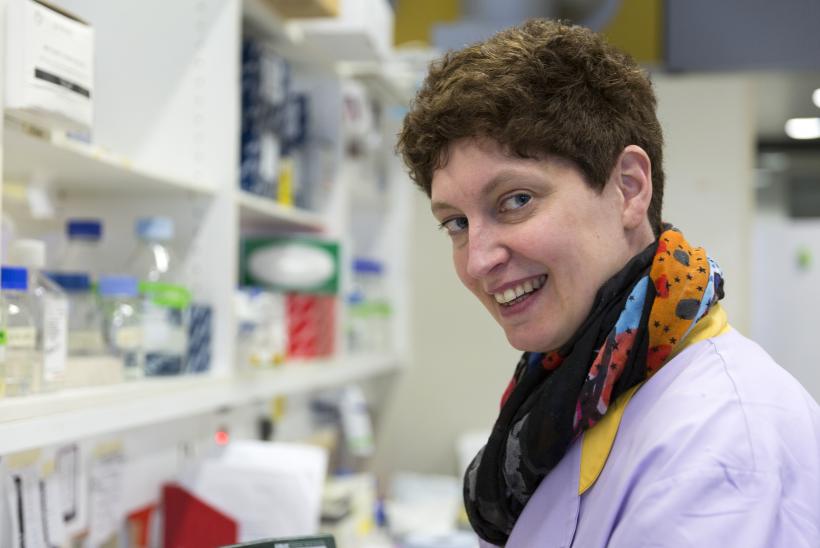An Interview with Karin Straathof Paediatric Oncologist and Wellcome Trust Clinician Scientist
Each year in the UK, around 30 children are diagnosed with diffuse intrinsic pontine glioma (DIPG), the most common cause of brain tumour death in children. We urgently need new treatments for these children. We speak to award-winning Dr Karin Straathof, who tells us why immunotherapy may be a good option for treatment of brain tumours like DIPG which are very difficult to treat with chemotherapy and radiotherapy.
Congratulations on receiving the Dr Simon Newell Early Career Investigator of the Year Award, funded by Sparks.
Thank you very much. I’ve been very fortunate, and I feel honoured. I’m delighted, because not only does it mean a lot to be recognised for my work, but it’s also important for the people who have been teaching me, and the people I’ve been working with. It’s a team effort.
The award, in partnership with the Royal College of Paediatrics and Child Health, recognises the potential impact your immunotherapy research could have. What is immunotherapy and how can it help children with cancer?
Our immune system naturally recognises ‘foreign’ cells, hunts them down and destroys them. But because cancer affects our body’s own cells, the immune system usually sees these cells as ‘friendly’ and doesn’t attack them. I’m trying to change that by re-programming immune cells to recognise and destroy these tumour cells, while leaving our body’s other healthy cells unharmed. That’s immunotherapy – treating a disease by enhancing or supressing our body’s natural immune response.
We’re looking at a kind of immune cell called a T-cell. We want to modify these cells so that they produce a special molecule on their surface. Those molecules recognise a specific part of the cancer cell, signalling to the T-cell that they should hunt it down and destroy it. The molecules are called chimeric antigen receptors (CARs) and so the immunotherapy is called CAR T-cell therapy.
CAR T-cell therapy has already seen hugely promising results in children with blood cancers like leukaemia. My research explores using immunotherapy as a new treatment for children with brain and nervous system tumours. While chemotherapy drugs often do not reach tumours that are located in the brain, immune cells can readily travel to the brain and therefore we think that immunotherapy is well suited to treat brain cancer.
Another reason immunotherapy treatment may work well for brain tumours as well as other tumours in children is that it designed not to harm the child’s healthy tissue. You want to cure children without causing other long-term side effects, and immunotherapy has the potential to do that. At the minute, immunotherapy isn’t an option for many children with cancer because we need more research.
I think immunotherapy will have a significant impact on treatments for cancer – particularly childhood cancer – as many conventional therapies have a negative effect.
For example, radiotherapy and chemotherapy can sometimes have side effects such as damage to the heart, kidneys, lungs and thyroid gland, as well as impaired brain development and infertility. I think there is great potential for immunotherapy to address this deficit in conventional cancer treatments.
How did you first become interested in immunotherapy?
I’ve always been interested in doing a combination of research and clinical work. During medical school, I did an integrated degree where I studied both clinical medicine and biomedical science, which focuses on how cells, organs and systems function in the human body.
I wanted to focus on childhood oncology because, as treatment for cancer is a long process, you really get to know the child and their family. I like being a clinician, but it can be difficult when the best treatment you can offer still isn’t effective for some of your patients. Having this other side to my work, where I’m developing new and better treatments to improve the outcome for these patients, provides a nice balance.
You’ve recently been awarded funding through the GOSH Charity and Sparks national research fund. Tell us about your research project.
The grant is supporting the development of CAR T-cell therapy for children with a rare type of brain tumour called diffuse intrinsic pontine glioma (DIPG). DIPG is a tumour that grows around vital brain tissue, making it impossible to treat. Surgery, which is usually a major step in treatment for cancer, just isn’t an option. Currently, despite significant research into better treatments for children with DIPG, the average survival time after diagnosis is just 9–15 months.
We think there’s real potential in applying CAR T-cell therapy to DIPG, but first we need to find a unique marker that only appears on DIPG cells. We can then programme the T-cells to recognise this marker, so that they only destroy cancer cells and don’t harm any healthy tissue. To do this, we need to study the genetic code of DIPG tumours and compare that to healthy brain tissue, to find that unique marker.
We use samples that have been donated to the hospital for research. Without this step in our research, we can’t direct the T-cells safely to the tumour. We need to do this before progressing with developing the treatment.
How important are grants to research?
Really important! Grants allow you to build a solid set of data to demonstrate that your idea is valid and worth pursuing. Demonstrating the validity then allows you to apply for other, larger grants and to progress to clinical trials. Each step gets us closer to potential new treatments and cures and getting those breakthroughs to the children who need them most.



